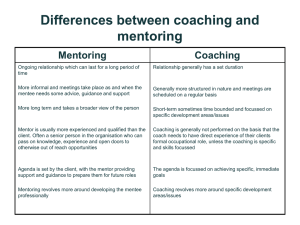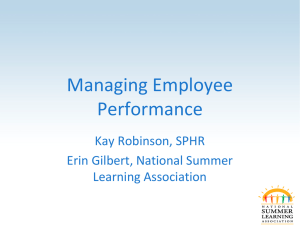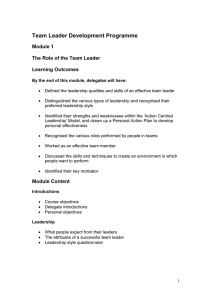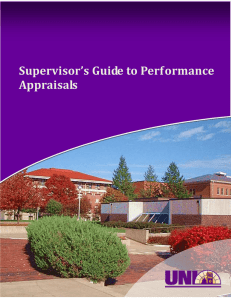8. Learning unit 8
advertisement
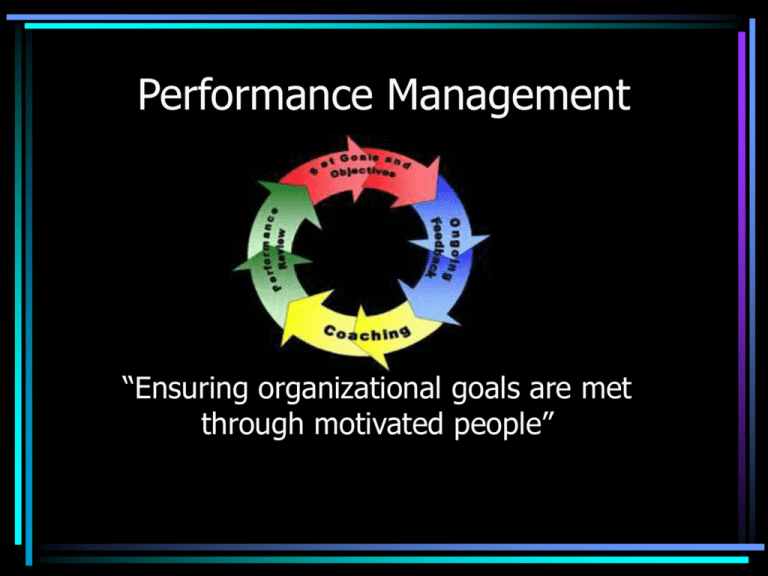
Performance Management “Ensuring organizational goals are met through motivated people” References • Learning unit 8 • Chapter 19 pages 491 - 505 • Notes • http://www.12manage.com/i_hr.html Outcomes At the end of this module you should: 1. Be able to describe the steps in developing a Performance Management system 2. Make decisions as to who should perform the evaluation 3. Compare relative and absolute performance evaluation techniques 4. Explain common rater errors 5. Conduct effective feedback interviews Drucker’s Five Needs • Tell me what you expect of me • Give me the opportunity to perform • Give me help when I need it • Tell me how I am doing • Reward me for my efforts Definition of performance mngt “The process of – guiding, – assessing and – recording of staff performance. To ensure that the companies strategic objectives are met, and personal goals satisfied. Aligning & engaging people Process of performance management 1. Aligning group & individual performance with business strategy 2. Coaching & mentoring 3. Evaluating performance & providing feedback 4. Reviewing and improving the system 1. Rolling out dept & individual goals 2. Ind coaching & mentoring Bus Strategy 4. Evaluating & Improving system 3. Performance reviews * “Purple Pear” • In groups • Please complete the case study • You may ask me questions as I am the HR Manager of “Purple Pear” 1. Aligning PMS to business strategy • • Mngr & subordinate agree how strategic goals be adopted by department & individual Agree an individual action plan • Agree progress checks • Agree the measures for evaluation and reward 2. Coaching & mentoring • Regular interim progress reviews & coaching sessions • May be informal and formal • Remove performance barriers • Create an environment conducive to performance 3. Performance evaluation Who should perform evaluation? • • • • • • • Immediate supervisor Peers Subordinates Self appraisal Customer appraisal 360* feedback Team appraisal 3. Performance evaluation RELATIVE JUDGEMENTS Vs ABSOLUTE JUDGEMENTS • Compare peers • Differentiate between employees • Ranking of employees • Performance based against agreed standards • Feedback more specific • Does not determine how good or bad the performance • May not differentiate between employees Rater problems & remedies 1. Unclear standards 1. Discuss & agree beforehand 2. Halo/horns effect 2. Be aware of total performance 3. Central tendency 3. Change rating to even number 4. Leniency/strictness 5. Recency * 5. Measure throughout period 6. Bias 7. Single criterion 6. Be careful of people we like/dislike 4. Training on how 7. Measure on a range of measures Appraisal interview 1. Before interview • Gather appropriate information, plan the intervention, get training on appraisals, communicate with employee 2. During interview • Encourage participation, focus on performance, be specific, provide motivational feedback, set action plans for improvement 3. After the interview • Review performance, coach, guide, amend goals if necessary 4. Evaluating performance mngt system Process of reviewing system and ensuring that the following are appropriate: – – – – Strategy & critical objectives Departmental & individual goals Coaching processes Review processes If not ~ change & communicate Next week • Workforce planning, employment equity and recruitment.



